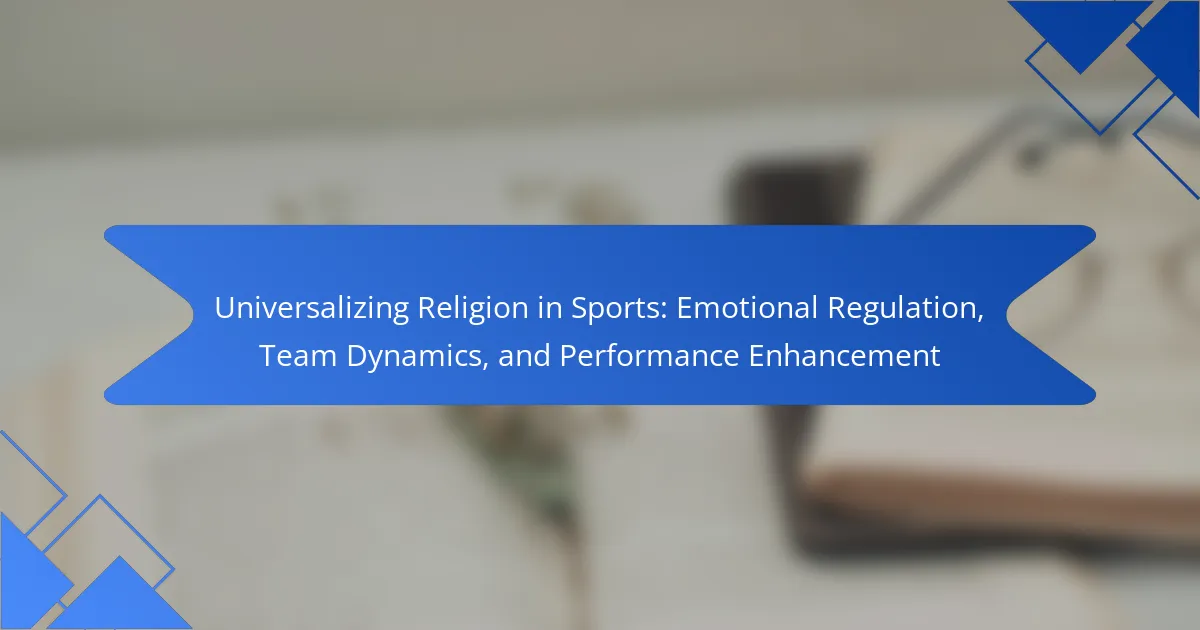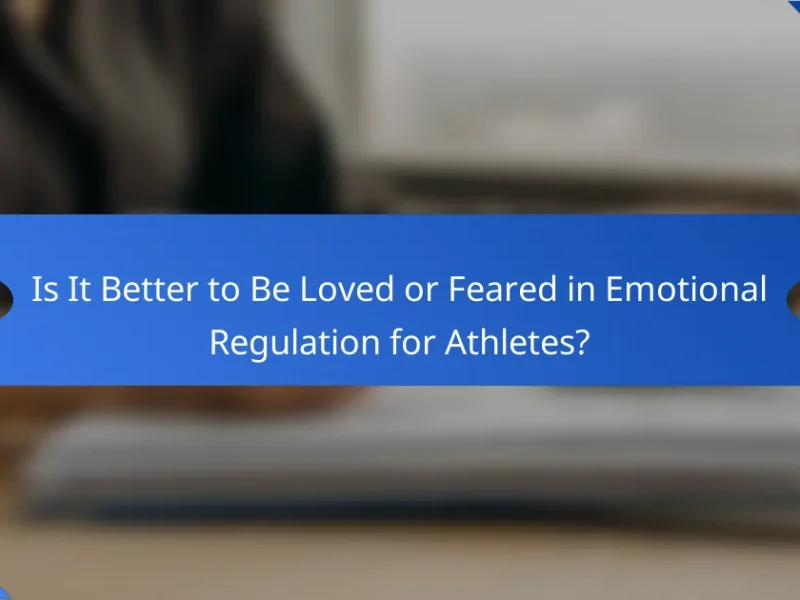Emotional regulation in sports is crucial for enhancing performance and team dynamics. This article explores how emotional regulation systems improve focus and resilience, the role of self-awareness and empathy in team cohesion, and the impact of mindfulness practices on overall performance. Additionally, it examines unique attributes like emotional intelligence and situational awareness that contribute to competitive advantage.
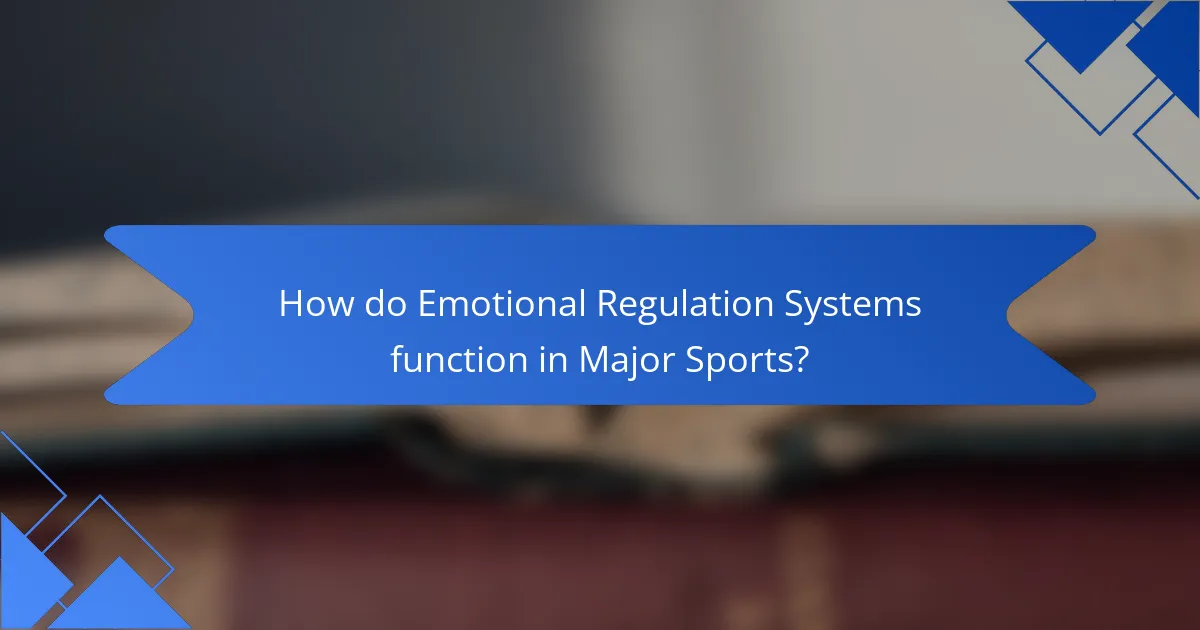
How do Emotional Regulation Systems function in Major Sports?
Emotional regulation systems in major sports enhance performance by managing athletes’ emotional responses. These systems help teams maintain focus, cohesion, and resilience under pressure. Effective emotional regulation fosters positive team dynamics, leading to improved outcomes in high-stakes situations. For example, athletes trained in emotional regulation techniques exhibit better stress management, resulting in enhanced performance consistency.
What are the key components of Emotional Regulation Systems?
Emotional regulation systems consist of cognitive appraisal, emotional awareness, and response modulation. These components help athletes manage emotions, enhancing team dynamics and performance. Cognitive appraisal involves evaluating emotional triggers, while emotional awareness refers to recognizing one’s feelings. Response modulation focuses on controlling emotional expressions, fostering a supportive team environment.
Why is Emotional Regulation crucial for athletes?
Emotional regulation is crucial for athletes as it enhances performance and team dynamics. It allows athletes to manage stress and maintain focus during competition. Effective emotional regulation leads to better decision-making and improved interpersonal relationships within teams. Studies show that athletes with strong emotional control experience less anxiety and perform better under pressure, ultimately contributing to overall success in sports.
What role does emotional intelligence play in sports performance?
Emotional intelligence significantly enhances sports performance by improving emotional regulation and team dynamics. Athletes with high emotional intelligence can manage stress, communicate effectively, and foster collaboration within teams. This leads to better decision-making during competitions and a positive atmosphere that boosts overall performance. Research indicates that teams with emotionally intelligent members often exhibit higher levels of trust and cohesion, resulting in improved outcomes.
How do athletes develop emotional resilience?
Athletes develop emotional resilience through training, support systems, and mindfulness practices. Emotional regulation enhances team dynamics and performance. Research indicates that athletes who engage in regular mental conditioning show improved adaptability to stress, leading to better outcomes in competitive environments. Techniques such as visualization and cognitive restructuring are effective in fostering resilience. Additionally, team cohesion and supportive relationships contribute significantly to an athlete’s emotional strength, enabling them to navigate challenges more effectively.
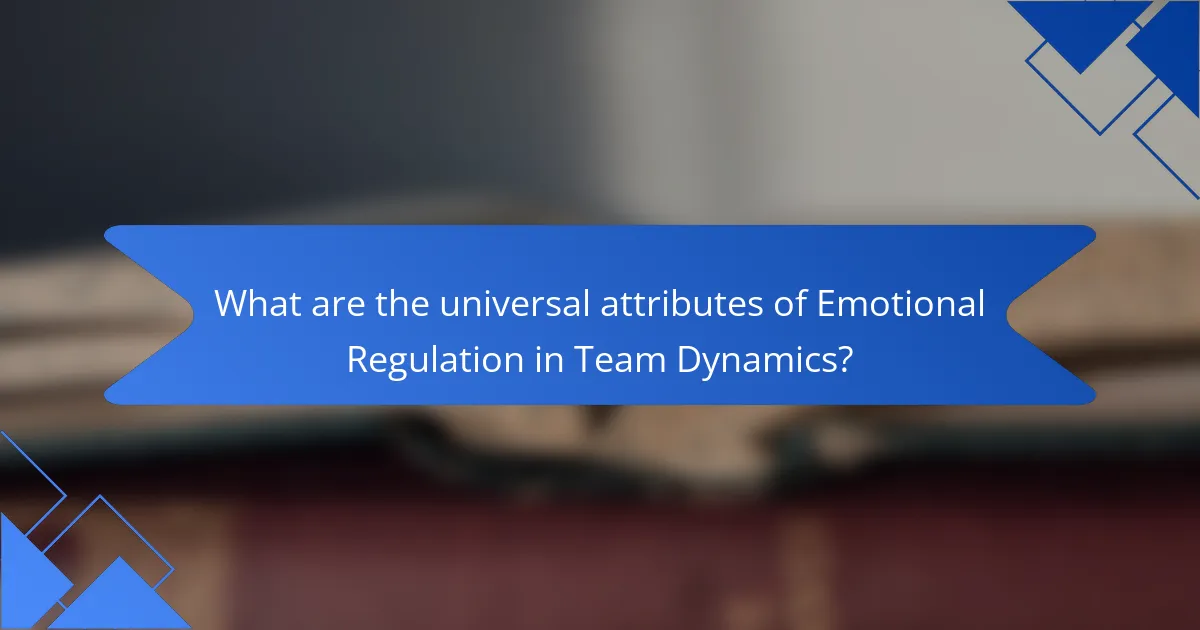
What are the universal attributes of Emotional Regulation in Team Dynamics?
Emotional regulation in team dynamics encompasses self-awareness, emotional expression, empathy, and conflict resolution. These universal attributes enhance communication and cohesion, leading to improved performance. Self-awareness allows team members to recognize their emotions, fostering better interactions. Emotional expression promotes openness, creating a supportive environment. Empathy builds trust and understanding, essential for collaboration. Conflict resolution skills enable teams to address issues constructively, maintaining harmony and focus on shared goals.
How does emotional regulation affect team cohesion?
Emotional regulation significantly enhances team cohesion by fostering trust and communication among members. Teams with strong emotional regulation skills are better equipped to manage conflicts and support one another, leading to improved collaboration. Research indicates that emotional regulation can reduce stress and anxiety within teams, promoting a positive environment that encourages performance. Additionally, effective emotional regulation contributes to shared goals and collective resilience, essential components of high-functioning teams.
What common strategies do teams use for emotional regulation?
Teams commonly use strategies like mindfulness practices, open communication, and structured emotional check-ins for emotional regulation. These approaches foster a supportive environment, enhancing team dynamics and overall performance. Mindfulness helps individuals stay present, reducing anxiety. Open communication encourages sharing feelings, which builds trust. Structured emotional check-ins provide regular opportunities to address and manage emotions collectively.
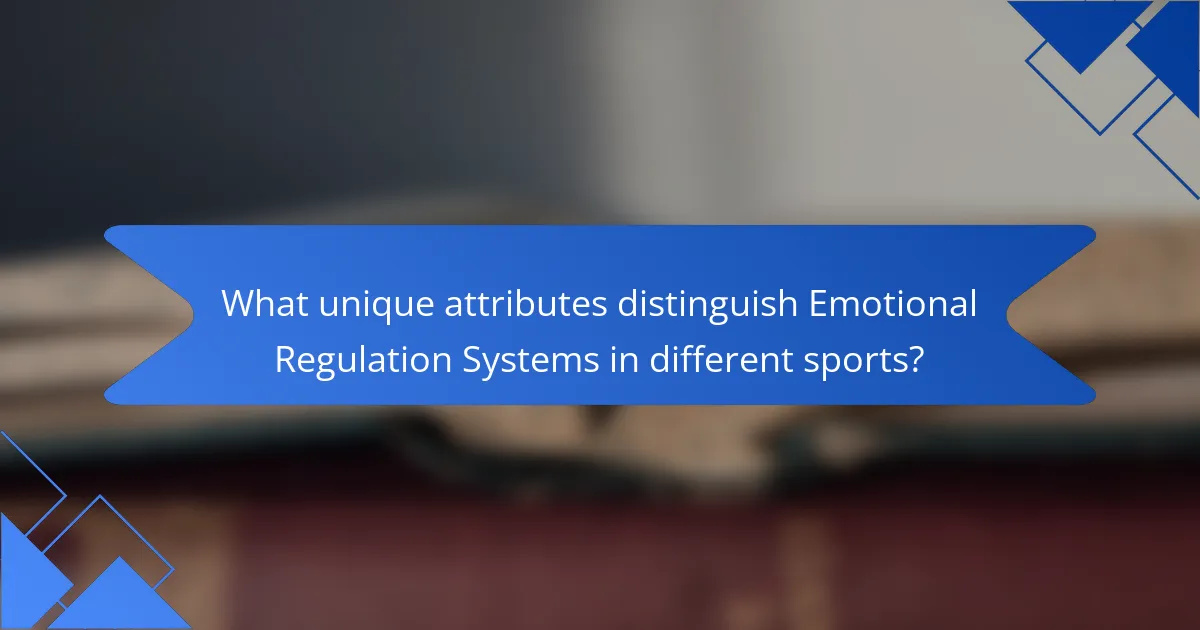
What unique attributes distinguish Emotional Regulation Systems in different sports?
Emotional Regulation Systems in different sports are distinguished by their unique attributes such as team cohesion, stress management, and adaptive strategies. For instance, team sports like basketball emphasize collective emotional regulation to enhance performance, while individual sports like tennis focus on personal coping mechanisms. The unique attribute of emotional synchronization in team dynamics fosters resilience and improves overall performance. Additionally, the rare attribute of situational awareness in high-stakes environments enhances athletes’ ability to regulate emotions effectively, contributing to competitive advantage.
How do individual sports differ from team sports in emotional regulation?
Individual sports require more self-regulation in emotional management compared to team sports, where dynamics influence emotional expression. In individual sports, athletes often face intense pressure to perform alone, leading to heightened stress levels. Conversely, team sports foster a supportive environment, allowing players to share emotional burdens and motivate each other. This social interaction can enhance emotional resilience, reducing anxiety and improving performance. Individual sports may also cultivate a unique attribute of self-discipline, as athletes must develop personal coping strategies. In contrast, team sports emphasize collective emotional regulation, promoting camaraderie and shared goals.
What specific emotional regulation practices are used in high-pressure sports?
High-pressure sports utilize specific emotional regulation practices to enhance performance and team dynamics. Techniques include mindfulness training, cognitive restructuring, and visualization. Mindfulness helps athletes stay present, reducing anxiety. Cognitive restructuring involves reframing negative thoughts, fostering a positive mindset. Visualization allows athletes to mentally rehearse successful performances, boosting confidence. These practices collectively improve emotional resilience, contributing to better outcomes in competitive environments.
How do different coaching styles impact emotional regulation?
Different coaching styles significantly influence emotional regulation by shaping team dynamics and individual responses. For instance, authoritative coaching fosters a structured environment, enhancing players’ emotional stability. In contrast, a more democratic style encourages open communication, promoting emotional expression and resilience. Research indicates that coaching styles characterized by empathy and support lead to better emotional outcomes, as athletes feel valued and understood. Ultimately, the right coaching approach can enhance performance by fostering a positive emotional climate within the team.
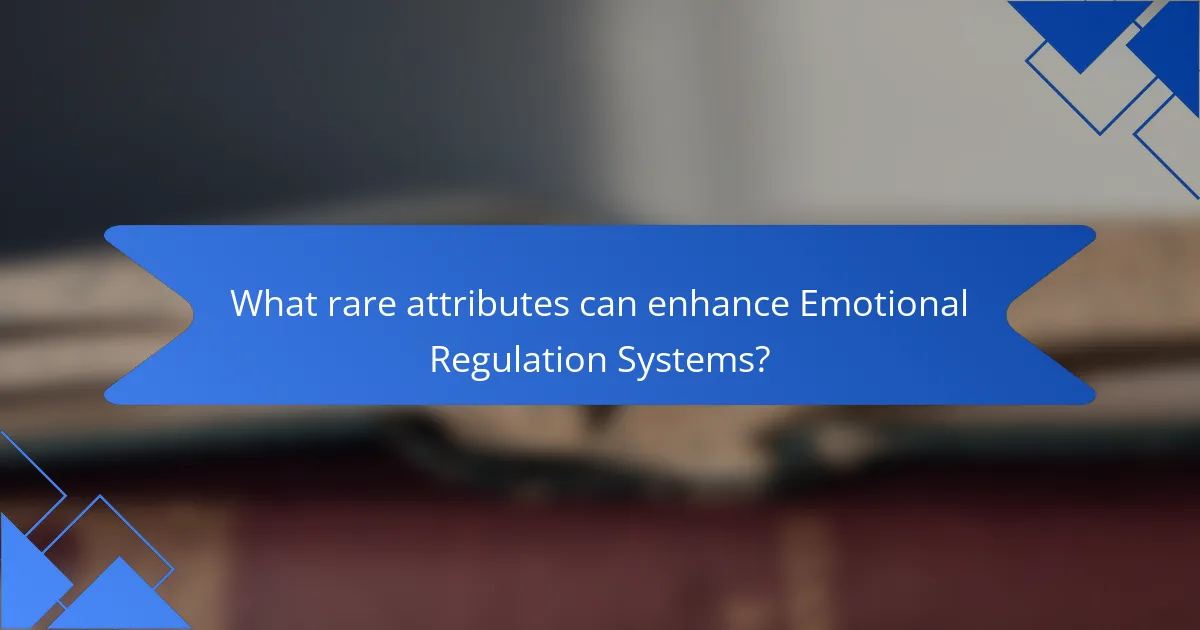
What rare attributes can enhance Emotional Regulation Systems?
Mindfulness practices can enhance emotional regulation systems in sports. These practices increase self-awareness, reduce stress, and improve focus. Unique attributes like emotional intelligence training and resilience-building exercises can further support team dynamics. Incorporating these elements fosters a cohesive team environment, leading to better performance outcomes.
What innovative techniques are emerging in emotional regulation?
Innovative techniques in emotional regulation are increasingly being integrated into sports. Techniques such as mindfulness training and cognitive behavioral strategies enhance team dynamics and individual performance. These methods promote resilience and emotional awareness, leading to improved focus and reduced anxiety during competition. Research indicates that athletes utilizing these techniques report higher levels of emotional stability and better performance outcomes.
How does cultural background influence emotional regulation in sports?
Cultural background significantly influences emotional regulation in sports by shaping athletes’ responses to stress and competition. Different cultures promote varying emotional expressions and coping strategies, impacting team dynamics and performance. For instance, collectivist cultures may emphasize group cohesion, leading to shared emotional experiences that enhance team support. Conversely, individualistic cultures might encourage personal emotional control, affecting individual performance under pressure. Understanding these cultural differences can enhance coaching strategies and improve overall team effectiveness.
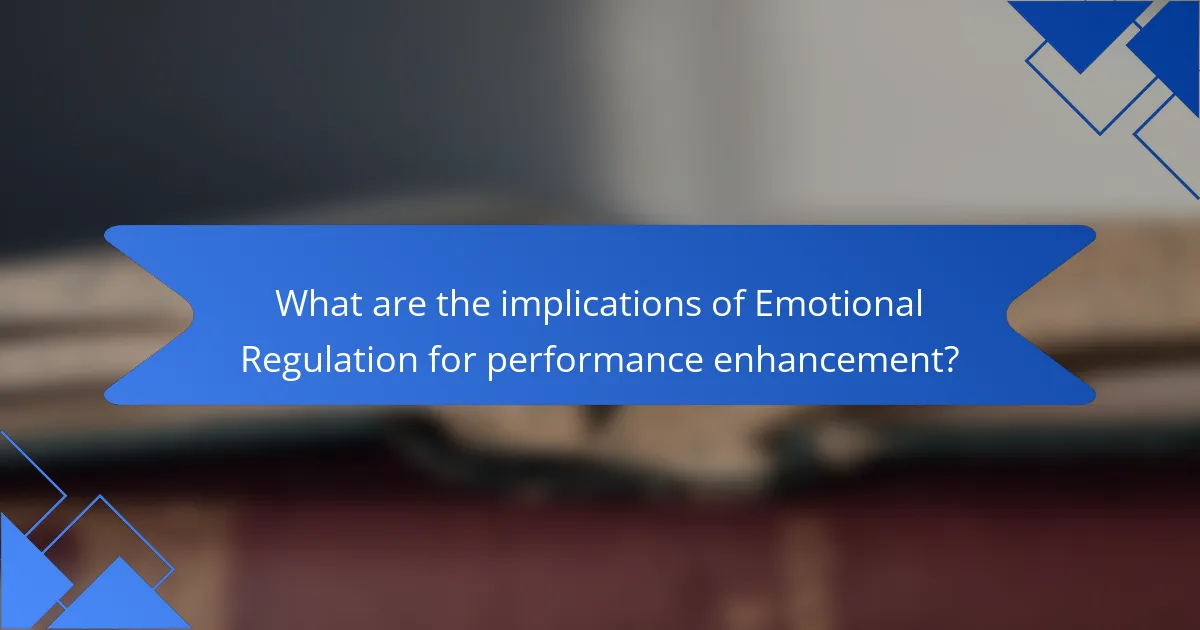
What are the implications of Emotional Regulation for performance enhancement?
Emotional regulation significantly enhances performance by improving focus, resilience, and teamwork. Effective emotional management allows athletes to maintain composure under pressure, leading to better decision-making. Team dynamics benefit from shared emotional awareness, fostering collaboration and trust. Studies indicate that teams with high emotional intelligence outperform those lacking it, highlighting the unique attribute of emotional regulation in sports performance.
How can athletes leverage emotional regulation for peak performance?
Athletes can leverage emotional regulation to enhance performance by managing stress and maintaining focus. This skill fosters team dynamics, leading to improved collaboration and communication among teammates. Effective emotional regulation techniques include mindfulness, cognitive restructuring, and emotional awareness. These strategies enable athletes to remain composed under pressure, facilitating peak performance during critical moments. Research indicates that athletes with strong emotional regulation skills often achieve better outcomes in competitive environments.
What are the challenges athletes face in maintaining emotional regulation?
Athletes face significant challenges in maintaining emotional regulation, including performance pressure, team dynamics, and mental health issues. High expectations can lead to anxiety, affecting focus and decision-making. Team conflicts can disrupt emotional stability, while injuries may trigger feelings of frustration and helplessness. Additionally, the lack of coping strategies can exacerbate these emotional challenges, hindering overall performance.
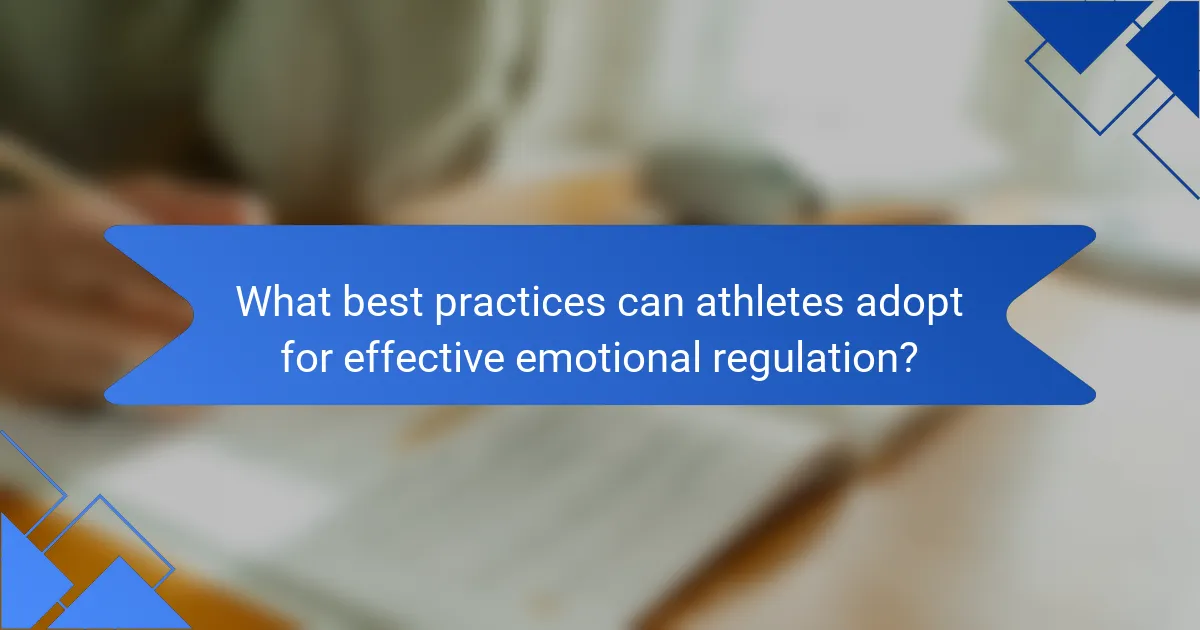
What best practices can athletes adopt for effective emotional regulation?
Athletes can adopt several best practices for effective emotional regulation. First, mindfulness techniques enhance self-awareness and emotional control. Second, establishing a pre-performance routine calms nerves and focuses thoughts. Third, fostering open communication within teams builds trust and support. Lastly, utilizing visualization strategies prepares athletes mentally for competition.
What common mistakes hinder emotional regulation in sports?
Common mistakes that hinder emotional regulation in sports include overgeneralizing emotions, neglecting self-awareness, and failing to communicate effectively with teammates. These errors can lead to heightened stress and decreased performance. For instance, athletes may assume their feelings are universally shared, which can create misunderstandings. Additionally, a lack of self-awareness can prevent them from recognizing triggers that affect their emotional state. Poor communication can exacerbate team dynamics, resulting in conflict and reduced cohesion. Addressing these mistakes is crucial for enhancing emotional regulation and overall performance.
How can teams create a supportive environment for emotional regulation?
Teams can create a supportive environment for emotional regulation by fostering open communication and trust. Establishing clear norms encourages team members to express emotions without fear of judgment. Regular check-ins promote emotional awareness and allow for collective problem-solving. Implementing mindfulness practices can enhance emotional resilience, leading to improved team dynamics. Additionally, recognizing individual contributions strengthens team cohesion and supports emotional well-being.
